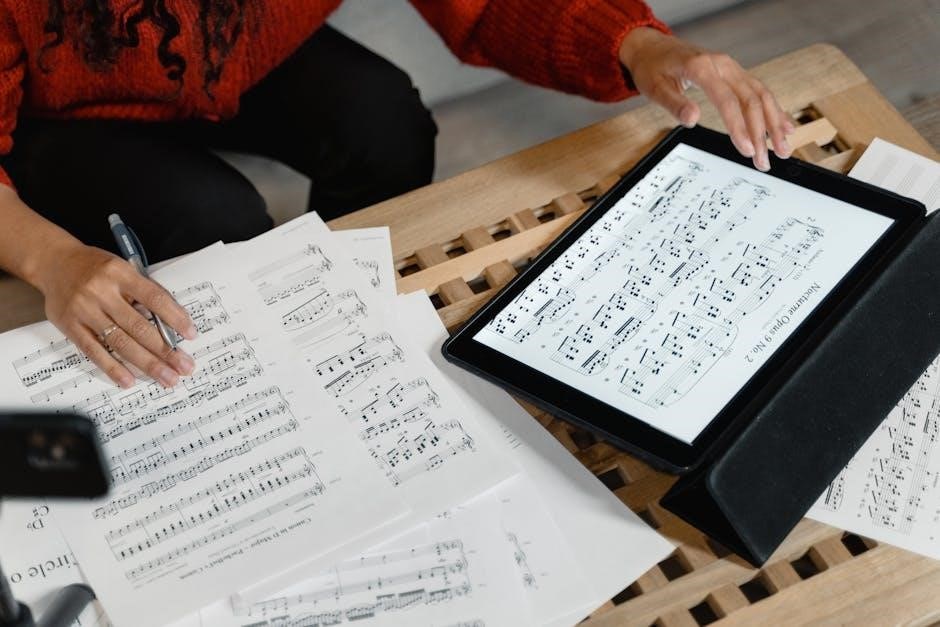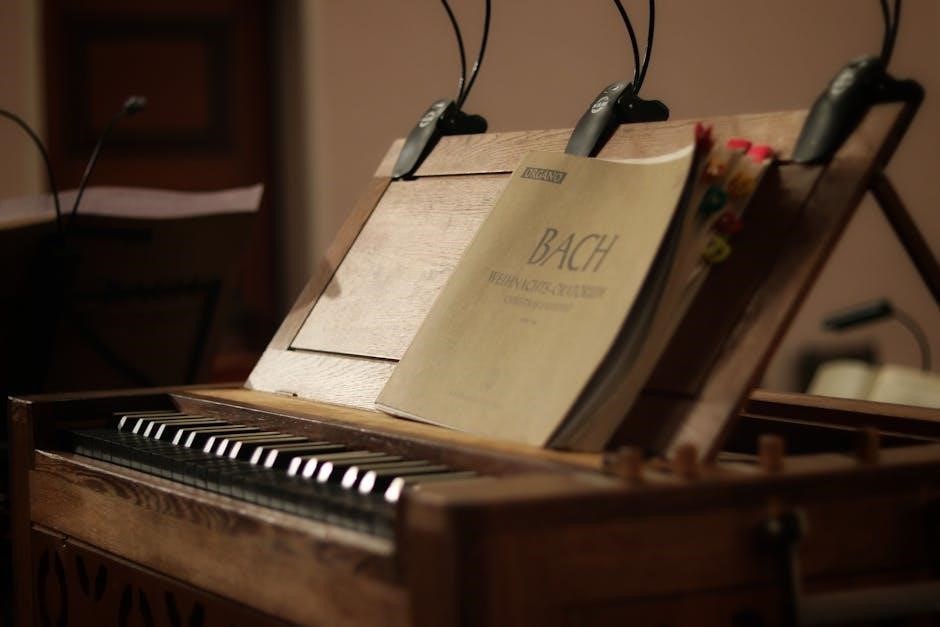
suzuki violin book 1 piano accompaniment pdf
The Suzuki Violin Book 1 Piano Accompaniment provides essential support for violinists, enhancing learning and performance. Available as a PDF, it includes pieces like “Twinkle, Twinkle, Little Star” and its variations, aligning with the Suzuki Method’s emphasis on early musical development. This resource is widely accessible through official sources and free download platforms, making it a valuable tool for teachers, students, and accompanists.
Overview of the Suzuki Violin School Method
The Suzuki Violin School Method, developed by Shinichi Suzuki, is a renowned approach to music education that emphasizes early musical training and parental involvement. Based on the “mother-tongue” philosophy, it encourages children to learn music naturally, like they acquire language. The method focuses on fostering a nurturing environment, where listening, repetition, and encouragement play key roles. The curriculum is structured to build technical and musical skills progressively, starting with simple pieces and gradually introducing more complexity. The piano accompaniment in Book 1 supports this process, providing harmonic and rhythmic guidance for young violinists. This approach has become a cornerstone of violin education worldwide.
Importance of Piano Accompaniment in Suzuki Violin Education
Piano accompaniment plays a crucial role in Suzuki violin education, providing harmonic and rhythmic support that enriches the learning experience. It helps young violinists develop a strong sense of pitch, timing, and musical phrasing by offering a structured yet nurturing framework. The accompaniment integrates seamlessly with the violin parts, creating a collaborative environment that mirrors real-world performance scenarios. This supportive role fosters confidence and expression in students, allowing them to focus on technique and artistry. Additionally, the piano accompaniment enhances the overall musicality, making practice and performance more engaging and enjoyable for both the student and the audience. Its inclusion is a cornerstone of the Suzuki Method’s effectiveness.

Structure and Content of Suzuki Violin Book 1
Suzuki Violin Book 1 features foundational pieces like “Twinkle, Twinkle, Little Star” variations and folk songs, designed to build technical skills and nurture musical expression progressively;
Pieces Included in Volume 1
Suzuki Violin Book 1 includes a carefully selected collection of pieces designed to introduce fundamental violin techniques. The volume begins with the iconic “Twinkle, Twinkle, Little Star” variations, followed by folk songs such as “Lightly Row,” “Song of the Wind,” and “Go Tell Aunt Rhody.” These pieces are arranged to progressively develop bowing and intonation skills. The repertoire also features traditional melodies like “O Come, Little Children” and “Maytime,” providing a diverse musical foundation. Each piece builds on the previous one, ensuring a logical and engaging learning experience for young violinists. The accompaniment scores are tailored to support these works, fostering musicality and expression from the earliest stages.
Progression of Difficulty and Technique
The Suzuki Violin Book 1 is structured to introduce techniques gradually, ensuring a smooth learning curve. Early pieces focus on open strings and basic bowing, progressing to simple finger placement. As the book advances, students encounter more complex rhythms and dynamics, such as legato playing and staccato articulations. The inclusion of variations on “Twinkle, Twinkle, Little Star” allows for repetitive practice of new skills in a familiar context. By the end of Volume 1, students are prepared to play simple melodies with proper intonation and bow control, laying a solid foundation for future technical development. This incremental approach aligns with the Suzuki Method’s emphasis on building proficiency through repetition and review.

Features of the Piano Accompaniment in Book 1
The piano accompaniment in Suzuki Violin Book 1 is simple yet supportive, providing harmonic and rhythmic guidance. It includes dynamic markings and bowing techniques to enhance learning.
Role of the Piano in Enhancing Violin Learning
The piano accompaniment plays a crucial role in enhancing violin learning by providing harmonic support and rhythmic stability. It helps students develop timing and intonation skills while fostering musical expression. The piano’s harmonic structure allows violinists to hear their part within a musical context, aiding in pitch recognition and tone production. Additionally, the accompaniment encourages ensemble playing skills, essential for future orchestral and chamber music performances. By integrating the piano, the Suzuki Method creates a balanced learning environment where technical development and musicality go hand in hand, preparing students for advanced repertoire and collaborative musical experiences. This collaborative approach enriches the learning process and nurtures well-rounded musicianship.
Key Characteristics of the Accompaniment Scores
The piano accompaniment scores in Suzuki Violin Book 1 are designed to provide clear harmonic and rhythmic support, ensuring the violin part remains prominent. These scores are structured to align with the violin pieces, offering a balanced and complementary sound. The accompaniments are written in a straightforward manner, avoiding overly complex harmonies, which allows for easy readability and performance. They include dynamic markings and tempo indications to guide both the pianist and violinist. Additionally, the scores are available in PDF format, making them easily accessible for practice and performance. Their simplicity and clarity make them an invaluable resource for fostering musical collaboration and technical development.

How to Access the Suzuki Violin Book 1 Piano Accompaniment PDF

The Suzuki Violin Book 1 Piano Accompaniment PDF is available through official sources like Summy-Birchard Music and free platforms such as FileRun and other websites online.
Official Sources for Download
The Suzuki Violin Book 1 Piano Accompaniment PDF can be officially downloaded from trusted sources like Summy-Birchard Music, the publisher of the Suzuki Violin School series. Additionally, the Suzuki Method International website offers access to the revised editions of the accompaniment scores. These official platforms ensure high-quality and accurate versions of the material. Users can also explore dedicated music education websites partnered with the Suzuki Method for secure and legal downloads. Always verify the authenticity of the source to avoid unauthorized or incomplete versions of the PDF. This ensures compliance with copyright laws and supports the creators of this valuable educational resource.
Free Resources and Websites Offering the PDF
Several websites provide free access to the Suzuki Violin Book 1 Piano Accompaniment PDF, enabling easy download for educational purposes. Platforms like FileRun and other music education sites offer this resource, often as part of their libraries for violinists and educators. Additionally, forums and music-sharing communities may host the PDF, allowing users to access it without cost. Some sites specifically highlight the Suzuki Violin Method ⎯ Vol 01 ⎯ Piano Accompaniments.pdf, ensuring it is readily available for those seeking the material. While these resources are convenient, it is essential to verify the authenticity and quality of the PDF to ensure it aligns with the official Suzuki Method standards. Always check for complete and accurate versions to support effective learning and performance.

Benefits of Using the Piano Accompaniment PDF
The Suzuki Violin Book 1 Piano Accompaniment PDF provides a convenient and accessible way to enhance violin learning. It supports effective practice, performance, and musical development, ensuring high-quality accompaniment.
Convenience for Practice and Performance
The Suzuki Violin Book 1 Piano Accompaniment PDF offers unparalleled convenience for both practice and performance. By providing a digital format, it eliminates the need for physical sheet music, allowing violinists and pianists to access the accompaniments effortlessly. This PDF is easily downloadable from various online sources, ensuring that musicians can practice anytime, anywhere. The accompaniment scores are clear and well-organized, making it simple for pianists to follow and perform alongside violinists. Additionally, the PDF format enables easy printing or digital display, reducing the hassle of managing paper copies. This convenience fosters a seamless learning and performing experience, enhancing the overall effectiveness of the Suzuki Method.
Enhanced Musicality and Expression
The Suzuki Violin Book 1 Piano Accompaniment PDF significantly enhances musicality and expression by providing rich harmonic and rhythmic support. The accompaniments are thoughtfully composed to complement the violin parts, allowing for a deeper exploration of phrasing, dynamics, and tone. This collaboration between violin and piano fosters a more engaging and expressive performance, helping students develop their musical sensitivity. The accompaniment scores often include subtle nuances that guide young musicians in understanding the emotional depth of each piece. By practicing with these accompaniments, students can refine their bowing techniques, intonation, and overall artistic interpretation, thereby elevating their musicality to new heights. This synergy between the violin and piano is a cornerstone of the Suzuki Method’s success.

Tips for Using the Piano Accompaniment Effectively
To maximize the piano accompaniment, pianists should balance dynamics with the violin, maintaining a supportive yet subtle presence. Encourage interactive practice, adjusting tempos to suit the violinist’s needs.
Guidelines for Pianists Accompanying Violinists
Pianists accompanying Suzuki violinists should focus on providing a balanced and supportive foundation. Dynamics and articulation must complement the violinist’s interpretation, ensuring the piano does not overpower the solo instrument. Tempo adjustments should be subtle, aligning with the violinist’s pacing while maintaining rhythmic accuracy. Communication is key; pianists should be attentive to the violinist’s phrasing and expressive nuances. Practicing together regularly helps build ensemble cohesion and ensures a unified performance. Additionally, pianists should familiarize themselves with the Suzuki Method’s philosophical approach, emphasizing tone production and musicality. By doing so, they create an ideal accompaniment that enhances the violinist’s learning and performance experience.
Strategies for Integrating the Accompaniment into Lessons
To effectively integrate the Suzuki Violin Book 1 piano accompaniment into lessons, synchronize the violin and piano parts by ensuring both musicians have the correct editions. During practice, focus on dynamics and tempo, allowing the piano to support the violin without overpowering it. Use the accompaniment for technique practice to maintain steady tempos and for musicality to enhance harmony. Incorporate the accompaniment into group lessons to foster a collaborative environment, ensuring it complements multiple players without causing chaos. Utilize the PDF format by printing or using digital versions for accessibility. Provide balanced feedback on both the violinist’s performance and the pianist’s accompaniment to promote mutual improvement. This approach aligns with the Suzuki Method’s emphasis on support and musicality, enriching the educational experience.

Revised Edition of Suzuki Violin Book 1
The revised edition of Suzuki Violin Book 1 features updated content, including “Twinkle, Twinkle, Little Star Variations,” with improved clarity in the piano accompaniment scores.
Updates and Improvements in the Revised Version
The revised Suzuki Violin Book 1 Piano Accompaniment PDF introduces several enhancements. The scores now feature clearer notation, making it easier for pianists to follow. Additionally, tempos and dynamics have been refined to better align with the violin parts, ensuring a more harmonious collaboration. The revised edition also includes updated fingerings and bowings, which aid in technical accuracy. Furthermore, the layout has been improved for better readability, reducing page turns during performances. These updates reflect the Suzuki Method’s commitment to fostering musical excellence and accessibility, providing both teachers and students with a more effective learning tool.
Comparison with Previous Editions
The revised Suzuki Violin Book 1 Piano Accompaniment PDF offers notable improvements over earlier versions. Previous editions often had denser notation and less clarity, which could hinder performance. In contrast, the revised version features cleaner layouts, reducing page turns and enhancing readability. Additionally, earlier editions lacked some of the refined dynamics and tempos now included, which better support the violinist’s learning process. The updated fingerings and bowings also address technical challenges that were less detailed in prior versions. These enhancements make the revised edition more aligned with the Suzuki Method’s philosophy of nurturing musical talent through clear and accessible resources. This progression ensures a smoother and more effective learning experience for both students and teachers.

The Role of the Suzuki Method in Violin Education
The Suzuki Method revolutionizes violin education by fostering early musical development through nurturing environments. It emphasizes parental involvement, ear training, and gradual technique refinement, ensuring a holistic learning experience for children worldwide.
Philosophy and Goals of the Suzuki Approach
The Suzuki Method, developed by Shinichi Suzuki, is rooted in the belief that every child can learn through a nurturing, supportive environment. Its philosophy, often referred to as “Talent Education,” emphasizes that musical ability is not innate but can be cultivated like language. The approach focuses on ear training, parental involvement, and gradual skill development, fostering a deep love for music. The primary goal is to develop the whole child, enhancing not only technical proficiency but also discipline, sensitivity, and expression. By using repertoire such as folk songs and classical pieces, the Suzuki Method aims to create a well-rounded musician and a compassionate individual.

Global Impact and Popularity of the Method
The Suzuki Method has gained worldwide recognition for its innovative approach to music education, with millions of students across the globe benefiting from its principles. Its emphasis on early childhood education and the belief that every child can learn has made it a cornerstone of violin instruction. The availability of resources like the Suzuki Violin Book 1 Piano Accompaniment PDF has further expanded its reach, allowing teachers and students in diverse regions to access high-quality materials. The method’s popularity is evident in its adoption by schools, workshops, and festivals worldwide, fostering a sense of community among musicians. Its adaptability to different cultures and languages has cemented its status as a leading pedagogical approach in violin education.
The Suzuki Violin Book 1 Piano Accompaniment is a valuable resource for violin education, offering structured learning and harmonic support. Its widespread availability enhances accessibility for students globally.
Final Thoughts on the Value of the Suzuki Violin Book 1 Piano Accompaniment
The Suzuki Violin Book 1 Piano Accompaniment is an indispensable resource for violinists and educators, offering a structured approach to learning. Its availability as a PDF ensures accessibility for global use, supporting both practice and performance. By providing harmonic depth and rhythmic guidance, it enhances musical understanding and expression. The inclusion of pieces like “Twinkle, Twinkle, Little Star” and its variations aligns with the Suzuki Method’s emphasis on nurturing musical talent from an early age. With options for downloading from official and free sources, this accompaniment remains a vital tool for fostering musical growth and appreciation worldwide. Its enduring popularity underscores its lasting value in violin education.

